Updated: January 24, 2024- 32 min read
Just last week we were in New York City with thousands of Product People and some of the biggest names in the Product Management industry. The energy was electric, the conversations were fascinating, and the coffee was free. Getting FOMO? Don’t fret. We’ll give you a rundown of what you missed! Make sure to use the Table of Contents above to navigate the talks.
For speaker videos and slides, see the ProductCon New York Rewind.
How De-Risking Big Bets Can Drive Impactful Product Innovation
Speaker: Michelle Parsons, Product Executive in Residence at Product School. Former Product Leader at Netflix & Spotify
Key takeaway: Break your strategy down into component pieces, clarify the big bets that you want to take, and then de-risk those by 1) identifying your core hypotheses, 2) identifying the data that's informing those hypotheses, and 3) testing those in a very easy low risk way that minimizes your resource investment (you don’t always have to create something net new!)
Michelle gave an incredible talk drawing from her experience at Netflix based on her experience on the Global Kids and Family team as Product Innovation Lead.
Michelle contends that great strategy is nothing without great execution, and that great execution is nothing without great strategy. So, how do you have both? Through the Balanced Portfolio Framework. By identifying quick hits, small bets, and big bets aligned with your larger Product Vision, you can begin to prioritize and allocate resources appropriately.
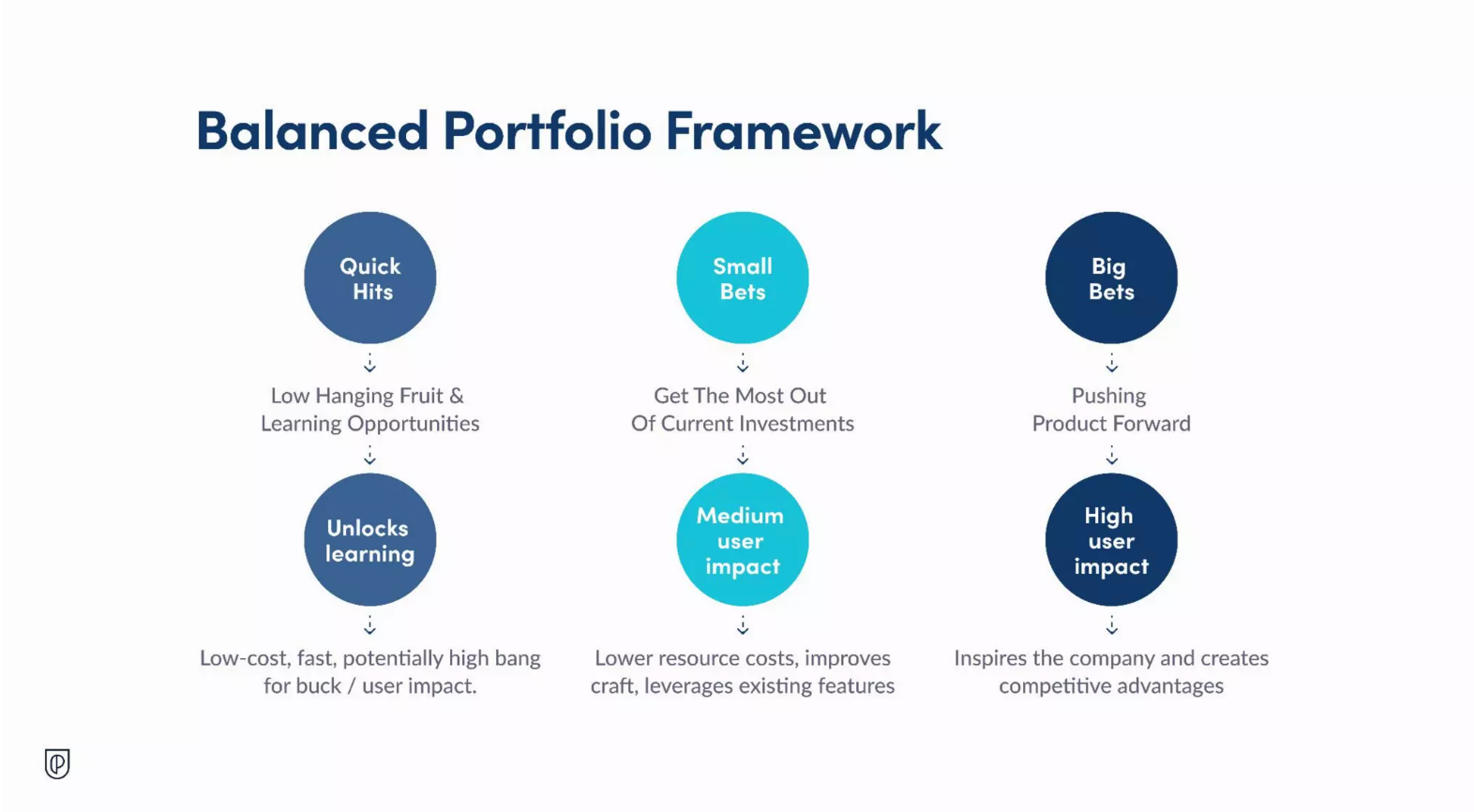
Big bets help us unlock exponential business and user growth, but they’re scary to pursue. You can stuck in the small bets lane because of this fear. And you’ll make movement with this, but you won’t 10x your business. Big bets can go wrong, but when big bets go right, they change the business and drive industry-wide change.
Big bets are worth it, but you have to get buy in by minimizing risk as much as possible. Michelle did this at Netflix when face with a huge challenge: The launch of Disney+. Suddenly, Netflix’s kids’ content lost its competitive advantage of hosting the big-name content kids already knew and loved. And as anyone with a little kid knows, when they love a TV show or movie, they really love it.
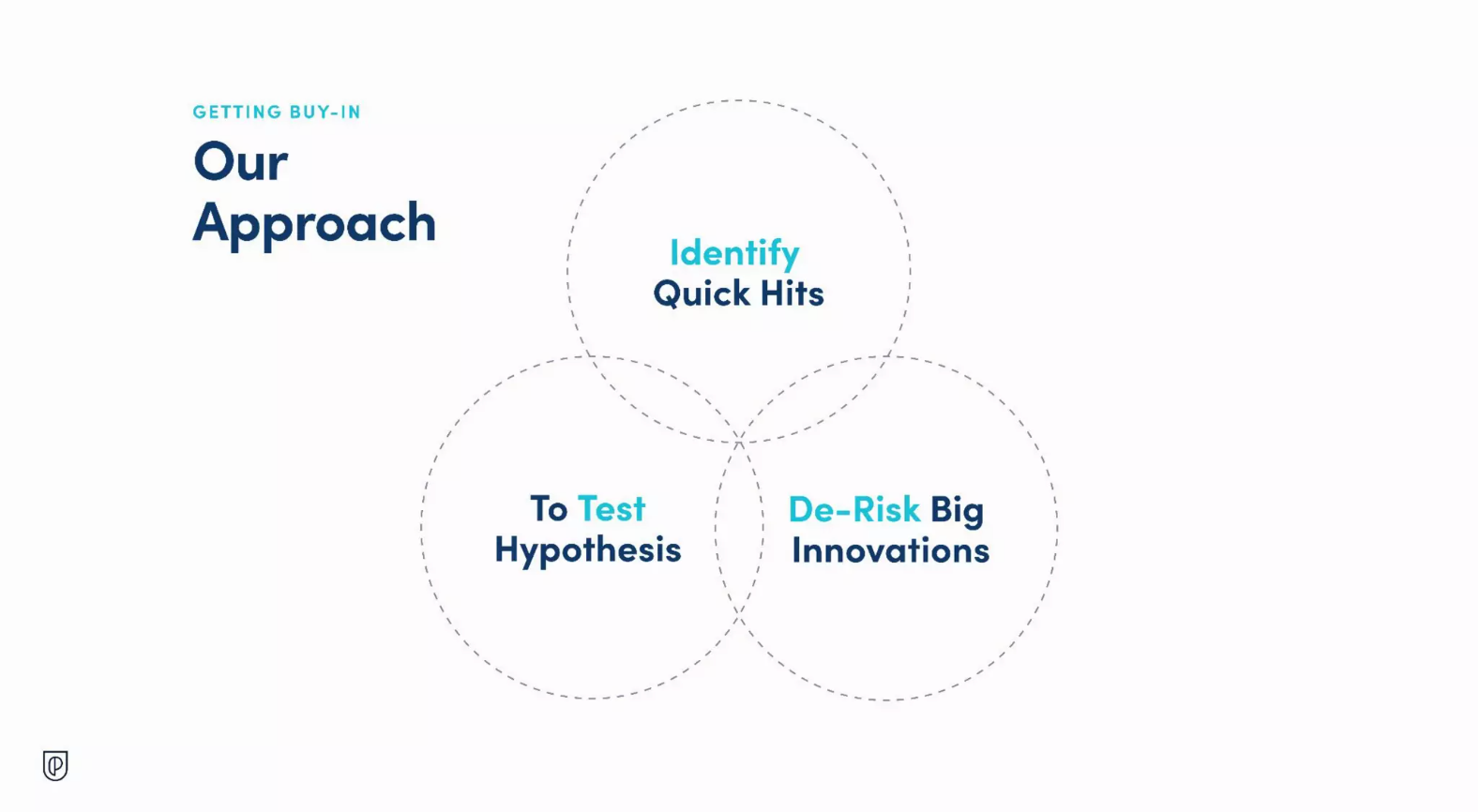
Michelle and her team set out to find a solution tied to their Team Vision: Make Netflix the number one trusted service that empowers kids to effortlessly engage with their favorite characters and delightfully discover new ones.
They had an idea: make the design and the algorithm focused on 1) favorite characters and 2) rewatch. This was a hard sell to stakeholders, who had already allocated resources in other areas and weren’t sure about a content and algorithm overhaul.
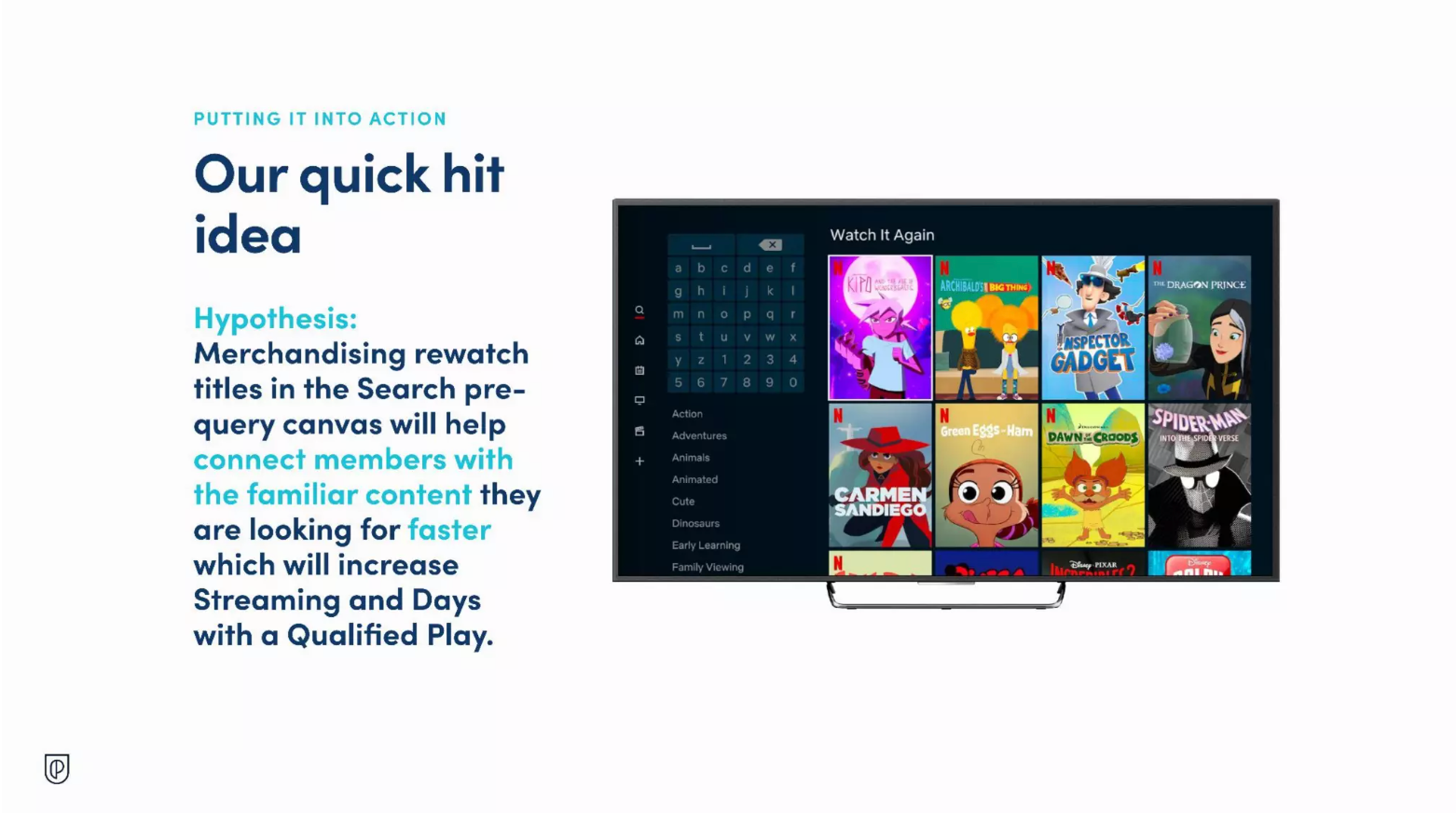
But Michelle and her team were convinced that this was a worthwhile big bet, because the data told them so. They knew that 57% of hours in kids profiles come from rewatch (compared to 20% from adults). So they took a small bet: They began to show their (already existing) “Watch again” algorithm at the top of the search function. The “Watch again” algorithm, which was previously difficult to find, was now the first thing kids and parents saw on search. Stakeholders were wary about this too—what if this negatively impacted discoverability?
They eventually agreed to the small bet test. And guess what happened? Netflix saw a 3x increase in watch time for kids, plus an increase in retention (a notoriously difficult metric to move). This stunning success got them buy-in for the big bet: changing to a character first UI presentation, approaching discovery in a new way, and overhauling the home page.
By using what they already had in their toolkit, they were able to validate their big bet hypothesis and drive huge impact.
Building Better Tech: The Product Manager's Role in Infrastructure & Platform Engineering
Speaker: Justin Kim, VP of Product at Vimeo
Key takeaway: Platform teams usually don’t have dedicated PMs, and this is a mistake! Product Managers make the teams building these products more successful. Deliver efficiently and effectively to external customers through building a solid internal platform and infrastructure foundation.
Platform and infrastructure products are often overlooked because they’re not as shiny and exciting as external customer-facing products, but they’re crucial for a business’s success. There are 3 types of platform and infrastructure technologies:
Platforms on which others build, test, and deploy software (e.g. backend systems for media playback)
Platforms that run the elements of the customer experience (e.g. payments)
Platforms that are part of the companies offering (e.g. AWS)
Dev and platform teams are often seen as engineer-driven. Platform teams usually don’t have dedicated PMs, and this is a mistake. With a Product Manager, dev teams spend more time coding and less in meetings, and you get higher ROI as you focus on impactful initiatives.

These are tasks that companies ask engineers on Platform teams to do:
Communicate internally and “sell” architecture and and infrastructure improvement projects to stakeholders
Align Platform team efforts to broader company strategies (such as to company-level OKRs)
Tie technical business decisions to quantitative business metrics
Mediate conflict
…in other words, all the tasks that Product Managers are especially equipped for. Sure, your engineers can do these tasks. Just as lots of Product Managers can code and develop products. But why would we ask them to? It makes more sense to have let each employee focus on the specific function they’re trained in.
There are 2 big myths to break around platform Product Management:
Infrastructure and platform teams don’t have customers
You need to know how to code to be a PM on infrastructure and platform teams.
Myth 1: Infrastructure and platform teams don’t have customers
The customers of infrastructure and platform teams are internal customers. That’s great, because they’re easily accessible to you. But it’s challenging, because you’re also easily accessible to them, their requests, and influenced by the internal politics of the company.
The functions of feature PMs and platform PMs are essentially the same. Product Managers needs to:
Know their customer
Develop a Product Vision
Build a roadmap
Launch solutions
That’s it. And it doesn’t change just because your customer is internal. You need to talk with your internal customers (which can be as easy as going over and talking with them directly!) to develop a point of view on their needs, and also on the ultimate end user and customer for your company.
Myth 2: You need to know how to code to be a PM on infrastructure and platform teams

It’s helpful, but not necessary. What is necessary is developing system-level thinking—making sense of complexity by looking at wholes and relationships instead of breaking it down to parts. This is important for feature PMs, but even more important for platform PMs.
Other important skills are communication, tenacity, data, and stakeholder management. Going into a Platform team, you will probably be the first PM they’ll have had. Don’t go in with the mentality of, “I am PM, hear me roar.”
You need to go in humble and ready to learn and listen. The most important thing for a Platform Product Manager is to build trust with their team through:
Quick wins
Leaning on your strengths
Taking on tasks no one else wants to do
Managing the backlog
Protecting the team from unstrategic requests
Designers and Product Managers: Leveling Up Product Development and Each Other
Speaker: Chino Wong, VP of Design at Medium
Key takeaway: Get to know who you're working with. Not enough people take the time to do it! When you evaluate your relationship with your Product Designer across indicators like 1) introversion/extroversion and 2) research experience, it can help you work better together and with the whole team.
Chino has 2 decades of experience for both small and large tech companies under his belt, and in that time he’s learned a lot about relationships. Here are his Thoughts in Progress [TIP] on building a strong working relationship with your Product Designer:
So much of a Product Manager’s success depends on relationships. Product Managers are frequently saddled with ill-defined tasks and high pressure. So your success depends on your relationships. It helps to understand yourself and your partner, and know what each of you is bringing to the table.

For you to work best with you Product Designer, you must understand two things:
Where you and your designer partner fall on the introversion/extroversion spectrum
How much experience you each have with research
Understanding these two things will inform how you and your design partners show up in your roles, your expectations of each other, and how you lean on each other for support.
Introversion/Extroversion
Case 1: Introverted Product Manager, Introverted Product Designer
Both you and your design partner are introverted. In this case, you both need to make an effort to communicate cross-functionally to get support with extroverted tasks.
You can expand your circle and engage with engineers, marketing, success, sales, to with tasks that usually fall on Product Managers, like leading group discussions or facilitating workshops. Coach other team members (where appropriate!) to cover tasks you’re not optimized for. There’s no shame in being a world-class notetaker! You don’t have to lead every meeting to add something valuable.
Case 2: Introverted Product Manager, Extroverted Product Designer
This is where it gets interesting. If you work with an extroverted Product Designer as an introverted PM, this is a great opportunity to pass the mic to them. Product Managers are (sometimes unfairly) tasked with spearheading team building and icebreakers, but if you see your Product Designer is better suited for this, feel free to give them the reigns.
Case 3: Extroverted Product Manager, Introverted Product Designer
You might find your own job easier as an extroverted Product Manager, easily able to speak out in group settings and lead your team. But make sure to intentionally create space for your introverted Product Designer to voice their opinion!
Maybe they’re not a fan of speaking in groups, but they’re active on other asynchronous platforms or chat messaging systems. Find out where they’re engaged and meet them where they’re at. This will strengthen your partnership and communication, and you’ll learn a lot about what’s going on in your designer’s head and what’s important to them. They’re often tackling questions like, How can we mitigate risk? Are we adding to UX debt? As an extroverted Product Manager, you can then socialize these insights across the Product Team.
Case 4: Extroverted Product Manager, Extroverted Product Designer
In this situation, you have a built-in tag team partner. You’ll have no problem making yourselves heard within your team. This then is the perfect dynamic to spread the Product Vision to stakeholders outside of your team and even outside of the company.
Research Experience

In this case, research can cover everything from understanding the competitive landscape, opportunity sizing, and talking with customers. Plus traditional UX research like study design and UX testing! When you think about your partnership with your design partner, think about the dynamic between your respective experiences running research—this will set the tone for research moving forward.
Case 1: Inexperienced Product Manager, Inexperienced Product Designer
If you and your Product Designer both find yourself without research experience, stick together to learn more about it. Start a book club between the two of you and learn through doing. Learn about research tools and select the ones you want to become the foundation of your research initiatives.
Case 2: Inexperienced Product Manager, Experienced Product Designer
This is a frequent dynamic in Product Teams. If you find yourself with a design partner with tons more research experience than you, get excited! You can tap into their expertise and learn from them. Involve your design partner as early as possible in the design process and have them poke holes in your proposed strategy. To get more experience yourself, add yourself as a plus one in their market research and design activities.
Case 3: Experienced Product Manager, Inexperienced Product Designer
If you have lots of research experience and your design partner needs a hand, help them out with participant recruitment (one of the most notoriously difficult parts of research). You don’t want to do the Product Designer’s research work for them, but you can take advantage of the broad access to stakeholders and users you have both inside and outside the organization.
When you’re running opportunity sizing or looking at the competitive landscape, involve your Product Designer so they can expand their practice.
Case 4: Experienced Product Manager, Experienced Product Designer
With combined research experience between you and your Product Designer, you can run cool initiatives like creating a living repository of research insights. Further, if you both have research under control in your own roles, it’s time to branch out beyond the Product Team. If there is no research function in the organization (as is often the case), you two will be the best advocates for research in your company.
The Future of Product Management
Speaker: Carlos González De Villaumbrosia, Founder & CEO at Product School
Key takeaway: Learn the 3 big trends shaping the Future of Product Management: 1) In times of economic uncertainty, the best product wins. 2) Product finally has a seat at the executive table. 3) Talent retention matters more than ever.
If you work in Product, you’re in the right place at the right time. This is the best time in history to be building digital products. When Product School started 10 years ago, no one knew what Product Managers were. Now it’s a central function across industries. Over 33% of fortune 100 companies already have a Chief Product Officer (CPO), and that will grow to over 50% in the next year.
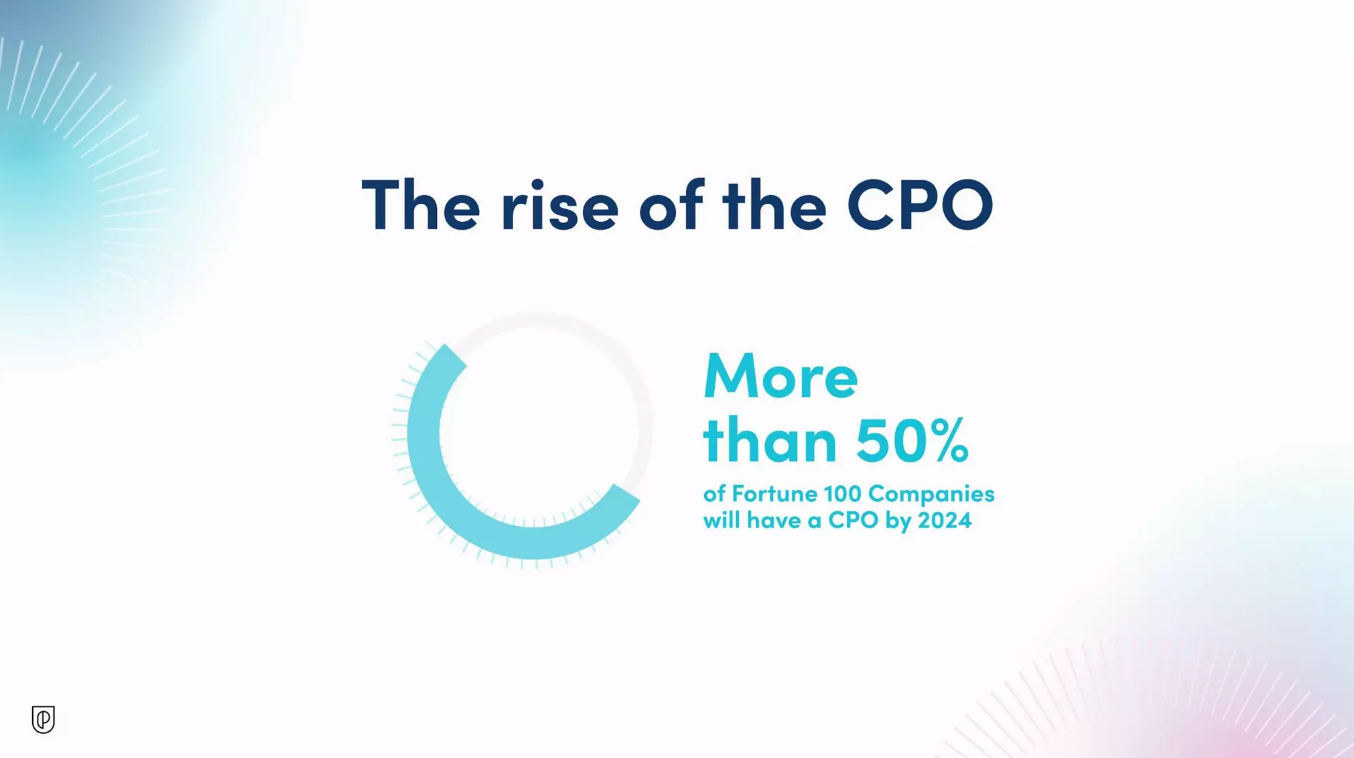
Now that we have our own seat at the table for CPOs, this affects people all the way down to aspiring PMs. People in undergrad school are choosing Product Management over different career paths like consulting and finance—even in New York City!
We’re also seeing the rise of the Product CEO; YouTube’s currently appointed CEO was formerly the organization’s CPO. Lots of startup founders are now coming with a Product background and changing the culture of those organizations.
We’re also seeing lots of software now being built for Product Managers, instead of us having to make do with tools made for other functions. What this software means for Product Managers is that we don’t need a tech background to get data, and we don’t need a design background to create a prototype. Now builders are much more self-sufficient.
In 2011, Marc Andreessen famously said that “software is eating the world.” In 2022, the transition finished the McKinsey company said “every company is a software company.” Over this period of time, as software made a meal of the world, the practice of Product-Led Growth took off. Users were able to get a taste of the product, and the product experience itself became a marketing engine.
When we got hit by a pandemic in 2020, lots of these tech breakthroughs were accelerated. Online became the channel to survive and thrive, so the role of the Product Manager became more mainstream. Then came the economic downturn. As jarring as layoffs in the tech world were and are, it’s telling that engineers and Product Teams are the roles least impacted by layoffs. Why? Because they provide the most innovation and value long term, and long term effective impact is now the name of the game.
There are 3 trends that are impacting companies and motivating them to go through the transformation to invest in Product as a long term strategy:
1. In an economic downturn, the best product wins.
You cannot fake a good customer experience. If your team is having a good experience, they will stay retained. Plus, those existing customers are your most cost-efficient way to get new customers. Leverage your product as an inbound channel to bring in new customers: In other words, Product-Led Growth (PLG).
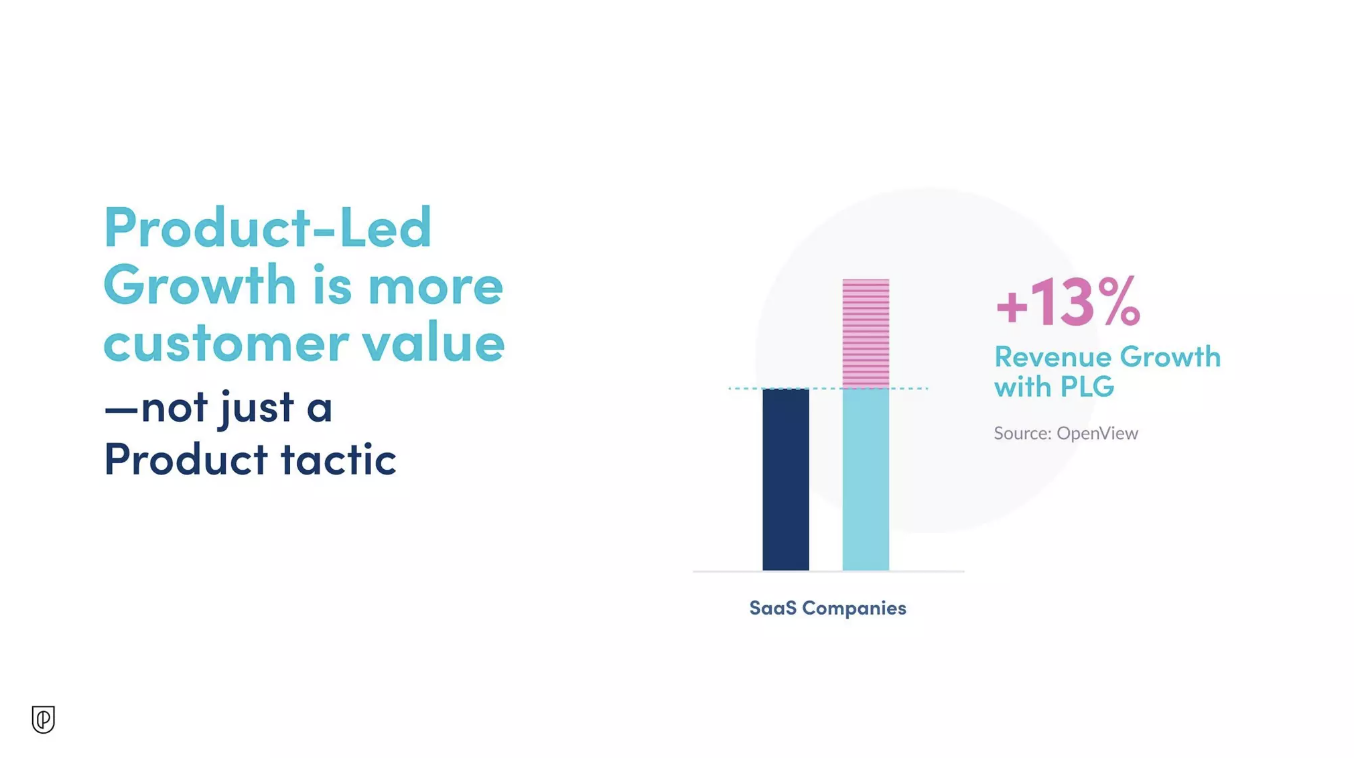
Companies implementing PLG are growing 13% faster than those who don’t. It’s tempting to see Product as a threat to Sales and Marketing-Led Growth, but the fact is that Product is actually Sales’s best friend. You get the best results when you use both Product and Sales-Led growth.
2. Product has a seat at the table.
Saying, “Product is the intersection of design, engineering, and marketing” no longer flies. Now, Product is at the intersection of everything: Sales, marketing, user research, data, customer success, and more. Companies are investing more in user experience and trusting Product Managers to align all of these various functions.
Companies are realizing that they have to focus on and invest in PMs. And not just in PMs—they are investing in the Product career. They have CPO, not just for the sake of checking the CPO box, but to actually prioritize Product as a primary function.
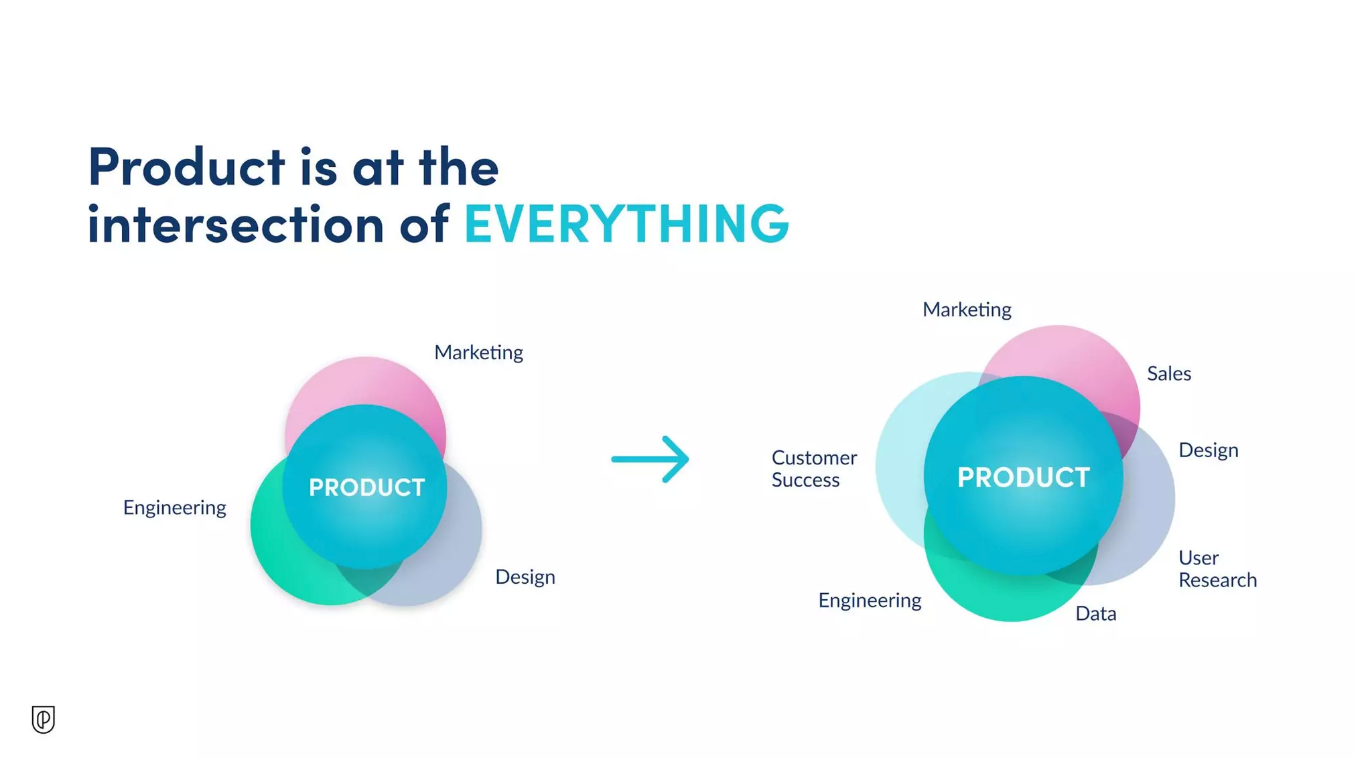
With this trend of increased investment in Product Marketing, companies are simultaneously building many product-adjacent roles to facilitate relationships with other teams (i.e. Product Marketing; growth product).
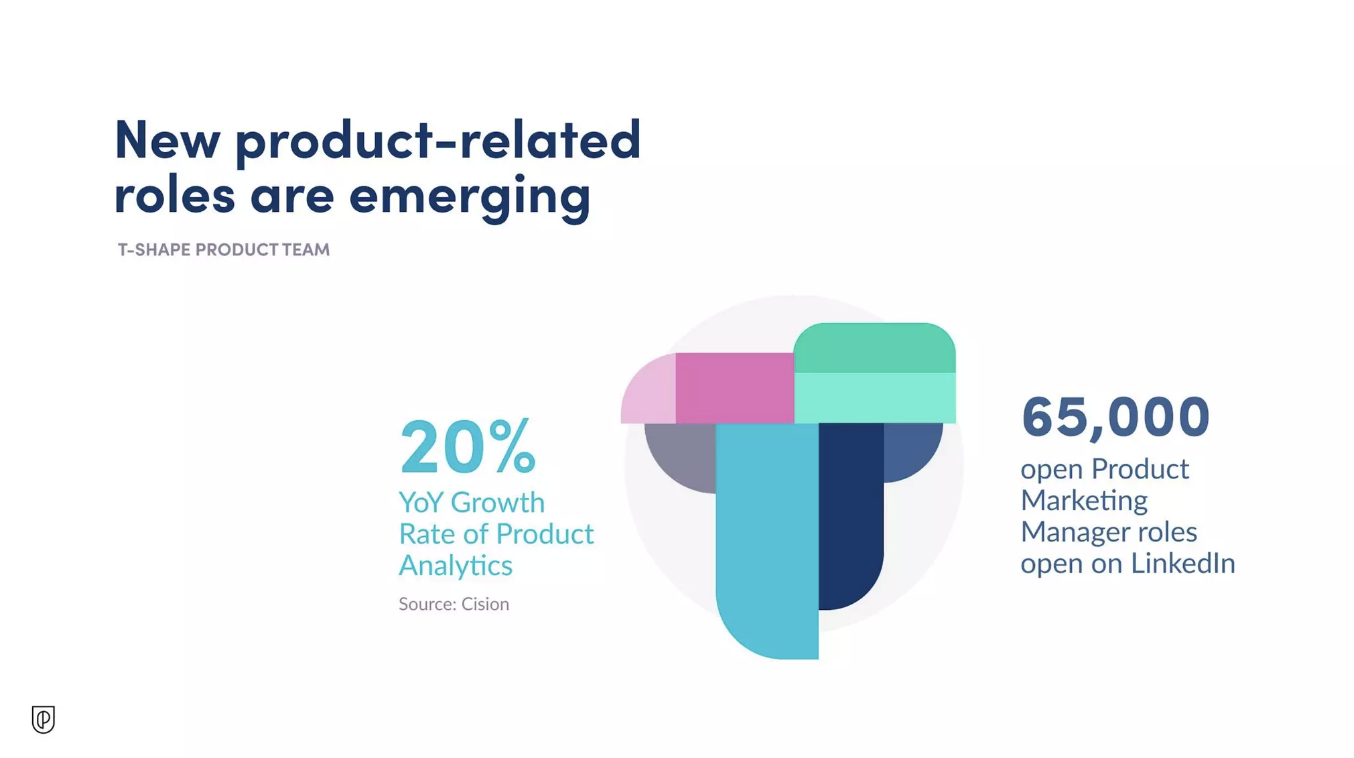
3. Talent retention matters more than ever.
Companies are scrambling to keep their Product Talent around.
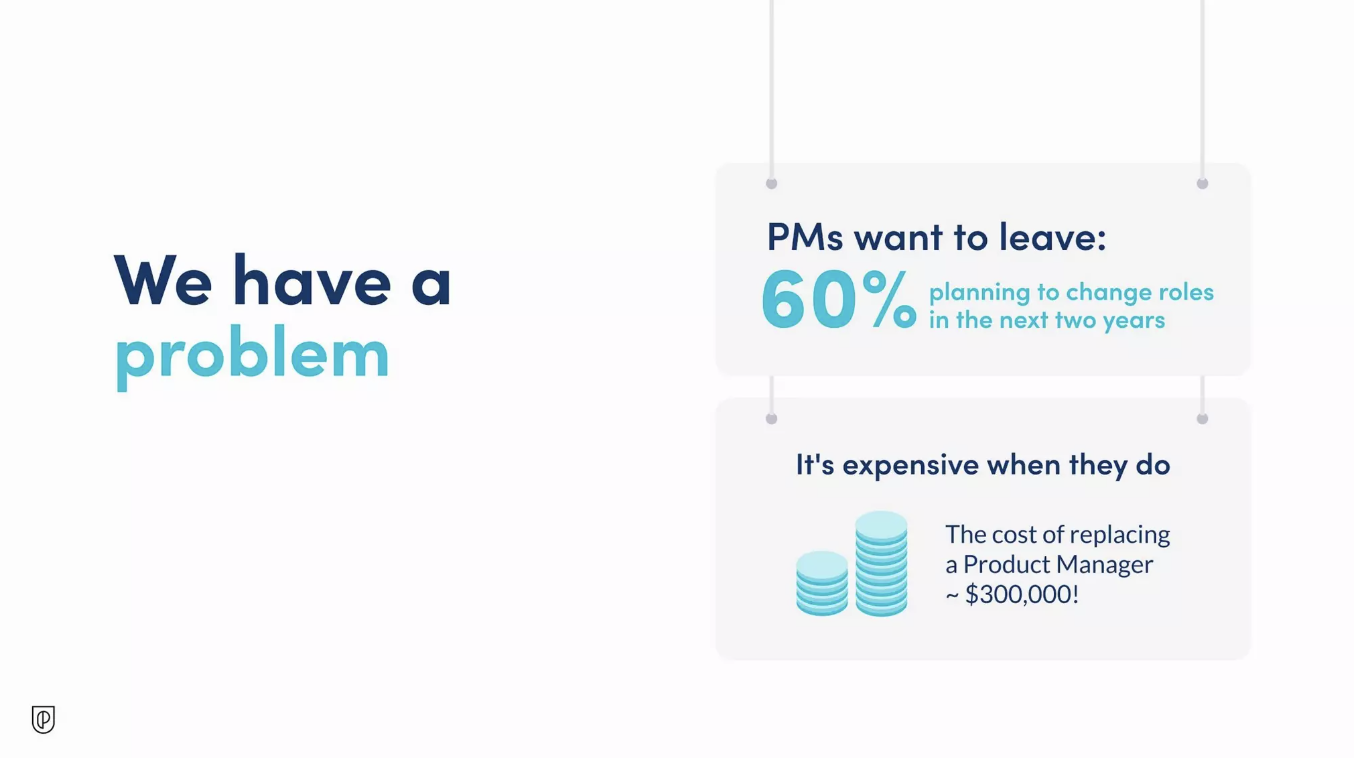
With increased interest in the field of Product Management, the harder it is to grab onto the best Product Management talent. These are the facts:
60% of PMs want to leave their current company in the next year. The cost of replacing a PM is 300k including ramp up time and onboarding.
But 94% of Product Managers say they would stay at their current company longer if it invested in their career growth.
41% of companies are increasing their budget for Learning & Development (L&D) in 2023
These 3 trends form a loop. As we invest in Product and good customer experience, we retain customers, and leverage those customers to bring more customers. Products aren’t a feature shipping function, they are strategic growth engine. To have good products, you need to invest in PMs and retain talent. In other words: Take care of your team, and they will take care of your customers.
Revolutionizing the Customer Experience: Innovating and Scaling Within Enterprise Organizations
Speaker: Margaret Ryan VP of Product at American Express
Key takeaway: Learn how to innovate within a large organization—it's possible, and sometimes even more effective than innovation in small organizations given the scope and resources you have access to.
Margaret Ryan works at Amex’s in-house innovation unit, Amex Digital Labs. Now, when you think about innovation, big companies don’t come to mind. But innovation within a big company is essential to stay relevant to your customer base and keep growing. It’s also easier in some ways because you have more resources to tap into.

The focus of Margaret’s team is short to medium-term adjacent opportunities that will provide value to existing customers: Innovations that will be relevant today and in the next couple years. This includes things like blockchain and web3, AI, next gen servicing, digital wallets, and exploring the future of work. Once a product reaches a certain scale in Margaret’s team, they graduate that product to another area of the business to keep the innovation team small and agile.
Here are the 4 key metrics the innovation team uses yearly and over time to measure success:
Revenue growth (direct and indirect growth caused by innovation products)
Number of new products launched
Customer engagement/satisfaction
Speed to market
The innovation team is structured into 3 types of roles:
Product Management: Ideating, creating, delivering, and managing products and experiences
Product enablement: Driving speed to market while balancing the critical need for controls, as well as providing tools and consultative guidance to enable agility across the team
Business development: Identifying market and partner opportunities, and defining and executing strategies to deepen customer value through tech solutions
Each role requires a different set of skills, but they all have certain traits in common: a growth mindset, customer-centricity, and curiosity.
Product Managers in this enterprise context have the same goals as a classical PM, but with the advantage of scale and resources—you’re leveraging all the resources a large multinational has to create an impact.
Both classical PMs and enterprise PMs pay attention to emerging trends; Enterprise PMs have a vast internal and partner network they can tap into to get further insight or to spread the word about their product.
Both care about solving customer problems; Enterprise PMs have a much wider reach of customers.
Both work catering to a business strategy; Enterprise PMs have the gift of time and testing before rolling out to market.
In short, classical Product Management lends itself to elegant solutions; Enterprise Product Management takes these elegant solutions to the level of impactful, industry-wide innovation.
For example: the virtual credit card number. This is an initiative in Amex spearheaded by Margaret’s team. Since eCommerce’s share of global retail is over 21%, this is an emerging area of innovation that’s important to capitalize on early. They leveraged their existing partnership with Google Pay to make this service available with payment options through Google Chrome. This virtual number is a one-time token that’s auto-generated while users are on the payment page. It’s easy, more secure than putting in your card number, and frictionless.
Amex used the gift of time to test this feature on 0.5% of their customers, and ironed out bugs before the full rollout. After full rollout, Amex noticed a 50% faster checkout speed as compared to those putting in their card number. They’ve seen some interesting use cases for this and are still observing to see future impacts on the industry, like on fraud rates for example.
In conclusion, the drivers of innovation success in large enterprise companies are:
Leaders and stakeholders who believe in and invest in innovation
Great talent who believe in the mission
Innovating just at the boundary to make progress without breaking trust (i.e. by taking on adjacent opportunities)
Establishing a track record of of piloting small successes before scaling across the enterprise (i.e. careful rollouts and validation)
Leveraging the power of enterprise backing
Panel discussion: Breaking Down Silos—Driving Product Knowledge in Product-Adjacent Roles
Moderator: Penny Ann Szeto, Head of Product Development at Amazon
Panelists: Hastu Kshitij, VP of Growth at MoEngage; Shintaro Matsui, Head of Product Operations at Amplitude; Adam Dille, SVP, Product and Engineering at Quantum Metric
Key takeaway: Having a unified vision can help break down silos, as well as building empathy and personal connection. Bringing folks along sooner, getting people involved, engaged, learning together, and building together is really important. It's not just on our product-adjacent partners. It's also the Product Team’s responsibility to lean in and learn more about other functions as well, and that's what's going to build the trust.

What are some of the best practices or mechanisms to foster cross functionality in teams?
Shintaro: Meet with your product counterparts. We have go-to-market reps share roadmaps with their respective teams, because the message resonates more with team members when they hear it from someone in their team rather than someone from another team.
Adam: I have PMs, designers, and engineers, shadow customers and the customer success team. Our customers can fall anywhere from highly technical up to business consultant. Shadowing helps our Product Team understand: What does success at this business look like? What can Quantum do to help? When there’s empathy with the struggle of the customers, people do their job better. When a PM or designer or engineer comes out with a better understanding of a customer need, they can deliver a better solution out to market. And that’s the biggest measure of success for me.
What can Product-adjacent partners do to better understand the Product Team?
Hatsu: Bring the Product Team in front of customers, and help customer-adjacent teams get in front of the Product Team as well. You can also get Product-adjacent teams to participate in the research and design (R&D) phase.
Adam: Give ongoing Product updates. We try not to skip Product updates in the weekly All Hands, because the company can follow the Product Team’s story arc. They’ll see when you have things in story phase, or in execution and go-to-market. And that opens the door for you to get help from people in other areas of the company. They hear about progress and potential roadblocks and might be able to help out.
We do embedding as well. We take people from outside of R&D and put them into Product pods and into Product Team standups to see how prioritization happens. So they use empathy but in the other direction, towards people internal to the company. That way they can understand your job better, and understand that it’s not so simple.
Any challenges you face with leadership as a silo?
Hatsu: Leadership is the hardest silo to communicate your perspective to. Use qualitative and quantitative data to help you here. Periodically update leadership on metrics they care about. And the qualitative side helps you present impact. Qual can matter more than quant.
Shintaro: Leadership is tough to crack. We hold a quarterly executive retrospective with leaders from different teams. There they list out different priorities and socialize so they can understand each other’s needs.
Adam: It’s so important to understand others’ needs. It’s easy to shoot an ask over Slack or email, and it’s easy to forget about others’ capacity. Sharing what’s on your plate brings us back to the team and back to what’s best for the customer.
Penny: I’d like to add something. At Amazon, we have these leadership principles. One of them is “Learn and be curious.” I like to interpret this about being curious about people and things. When thinking about silos, it’s valuable to break them down and ask, “why is this silo happening?”
Any closing thoughts?
Shintaro: Clarity on roles and responsibilities can help reduce silos.
Hatsu: As most Product Teams do, our Product Team always asks why, why, why. It’s also an important question for Product-adjacent teams to ask us—we should be able to answer them when they ask, “why are we doing this? Why is X taking so much time?”
Adam: Assume positive intent all of the time. No one builds a silo on purpose, everyone is heads down and these things just happen. Try and understand where others are coming from.
Product Leadership - from FAANG to Traditional Media
Speaker: Lisa Kamm, SVP of Product at The New York Times
Key takeaway: Product work outside of FAANG companies can be deeply rewarding. Learn about Product Management at The New York Times! Lisa Kamm compares and contrasts her time as Product Leader at Google vs the NYT. While the essentials of Product work remain the same, there are some key differences.
Lisa Kamm has worked in all kinds of companies, from a large tech company to traditional media. She was drawn to tech early in her career, and ended up spending 12 years at Google. There, she started in customer experience, then moved to Product Management.
Then, in 2020, she was recruited to The New York Times (NYT). She was hesitant at first to move to a non-tech company, but she quickly realized that the world had changed in her time at Google, and that every company now needs tech to get ahead.

Here are the main differences she spotted between the The New York Times and Google:
Both have huge ambition and impact, but the NYT has a sharper sense of mission & purpose. The mission of the times is to “seek the truth and help people understand the world”—a lofty vision that attracts a certain kind of talent.
There are more customer segments to pay attention to at the NYT. It’s not just the obvious external customer (the readers of the newspaper), but also internal customers like journalists and engineers. The newsroom is an important stakeholder. It’s its own separate organization. They’re both a customer and a collaborator.
The core Product skills needed at the Times and at Google are similar, but the Times has more focus on creativity and innovation.
Scope, impact, and flexibility are different. The Times simply doesn’t have the resources or the scope of users as FAANG companies. But it does have a legacy, a devoted readership, and an outsized impact on the world relative to its size.
Mission and purpose
The news industry has had an existential transformation over the past decade, and investing in tech allows the newsroom to keep moving forward and make independent journalism accessible. The NYT introduced a paywall in 2011, predicting that they had a potential market of 11 million customers willing to pay. In 2022, they had already reached 10 million subscribers, meaning they were almost at their limit.
But when restrategizing, they realized that including subscribers interested in other types of content like games, sports, and cooking, their potential audience base was more like 135 million. The now have a new goal to have 15 million subscribers by 2027, a target that they are working towards partially with the use of technology and Product Management.
A key benefit of working in Product at the Times is the mission-first approach to Product Management. And everyone knows the best products have the strongest vision! Having a clear product vision lets the Product Team break their work down into clear strategic goals:
Be the best news destination in the world, and a cornerstone of independent journalism
Become more valuable to meeting everyday needs. Sometimes people are looking for deep dives in journalism, but other times they want something lighter like Wordle and sports coverage.
Expand and connect the product to help subscribers engage with the full ecosystem of The New York Times (people who engage with multiple products have better engagement and retention rates)
Customers
It’s true that the Times’s total addressable market (TAM) is smaller than that of a tech company, but customer focus is still critical. Customer focus is the core of Product Management, regardless of where you do it. FAANG companies excel at focusing on this, and it’s the core of any iterative product work. It makes PMs be data-driven and understand their customers to make decisions based on research and how users use the product.
At the Times, they want to drive engagement and retention in each product. Yes, they want a universe of products, but they also want each product to be sticky in its own right. To make that happen, they have to take all customers into consideration:
Readers: The most well known customers, the obvious users
Newsroom: The newsroom is both a collaborator and a first-class customer.
Engineers: They need to be able to develop, deliver, and do the most impactful work of their lives.
The Product Team is constantly looking across these 3 different, specific sets of customers and delivering against the needs of all of them.
Core Product skills
The core Product skills needed at the Times are the same as any other Product Manager, but there are nuances.
FAANG companies talk about disrupting industries…The New York Times IS the industry they’re disrupting. They’re working on different ways to engage readers with the news: live insights from journalists as events are unfolding; different channels for news. They’re not only iterating and reinventing with tech, but with content and strategy, in order to adapt an old industry into the future.
Scope, impact, and flexibility
The NYT doesn’t have the scale of Google, but they do have the impact. Relative to their size, they punch above their weight. Scale is a mixed blessing and doesn’t always align with scope and impact. At the Times, you have more breadth in your Product work than at FAANG, but you need to take a bigger swing to deliver the same impact.
The Times also requires additional flexibility from its Product Managers. They have to readjust based on an external, unpredictable, and uncontrollable factor: The news.
As an example: Lisa’s first week at the Times was one week before they went into lockdown for the pandemic. They had to adjust their strategy on a dime; they began to share information on health and safety outside of the paywall.
You just don’t control the timeline. In other cases, the Product Team coordinates a big launch to avoid an important breaking story, but sometimes the story breaks on top of the launch and all the Product Team can do is pray there are no major bugs.
Also, the Times has more opportunity for people outside of tech to get into Product Management. There are Product Managers who are great with tech, but there are others who are talented at working with the newsroom and connecting people. Great Product Managers come from all backgrounds, and can drive impact across a wide range of organizations.
How to Get Promoted and Look Good Doing It (or at Least Not Get Laid Off)
Speaker: Matt Gray, Former Product Leader, Meta
Key takeaway: Learn how to get promoted in Product. You need to put yourself in your manager's shoes and understand: What does their story about you need to be in order for you to get promoted? What case can they make for you to their higher-ups? And what actions can you take to convince them to vouch for you?

When you start your role:
Be clear with your manager that you’re an ambitious person
Understand what success looks like to your manager
Understand who influences your manager’s view of you
Understand what gets promoted
Understand what performance looks like at each level of the career ladder
Understand the performance rituals of your company
Learn about the hidden culture at your company
As you execute:
Execute excellently
Define clear goals for yourself and your team
Track your own achievements
Capture positive feedback and recognition
Solicit critical feedback and act on it
Ask for public recognition
Regularly influence your manager
Regularly influence your manager’s manager
Regularly influence others who influence your manager
During feedback cycles:
Pull together a thorough self review
Game the peer review system
When you finally get promoted:
Show gratitude
Create a new 90-day plan
Making Products in GenAI’s World
Speaker: Jonathan Rochelle, VP of Product at LinkedIn
Key takeaway: If you're a Product Manager or aspiring Product Manager, you need to know about AI and generative AI. In the future we'll see AI in every single product we use, so it's essential that our builders stay up to date on the possibilities and limitations of AI solutions.

There are 33x more posts with keywords about GenAI as compared to a year ago. There are 79% more job posts mentioning GPT. And 86% of workers are using AI to help search for answers. There are countless developments and use cases happening with GenAI. As Product Managers and leaders, we need to keep up because we are the agents of change, not just in your role but in the world
We tend to reduce GenAI to ChatGPT, but ChatGPT is just one product. This said, ChatGPT is singularly responsible for the incredible boost and popularity of generative AI, which is within the big world of artificial intelligence. And while these technologies may not be new, what’s new is that everyone is talking about it. And when everybody is talking about it, you need to pay attention to not get left behind.
So let’s talk about the elephant in the room… Are Product Managers replaceable by GenAI? Maybe! When GenAI can:
Identify a problem in need of a solution
Propose and pitch a solution
Build and motivate a team
Project manage (a.k.a. Annoy a team to stick to a plan, all while keeping them engaged and committed)
Be optimistic in the face of doom
Prioritize and narrow the scope of the problem in the right way, in a way that’s best for the business
Make confident decisions without data
Some of these tasks will be hard for AI to replace. But there are 2 ways Product Managers can use GenAI: 1) As a user, to help them with their tasks, and 2) as features in their Product solutions.
Here are some general ways to use AI and Gen AI in your creation process:
Generate ideas
Research (with care—make sure the information you’re getting is accurate)
Write a product pitch
Generate slides
Develop demos scripts
Edit videos
Analyze data (AI is great at finding needles in haystacks)
Generate prototype code (you can get AI to participate a hackathon with you!)
Marketing ideas
When using large language models (LLMs) like ChatGPT in the Product process, make sure to use prompt engineering for most effective results. Test out different prompts to get the answers you want.
Here are a few ways Product Managers can put AI and GenAI features in their products:
Improved customer support
In-product natural language processing (NLP) search
Recommendations
Support users creating user-generated content (UGC)
Dynamic template generators
Creative/generative features
There are lots of possibilities in AI, but there are also some drawbacks to consider:
We’re still quite early in AI. Quality and accuracy is an issue.
Speed: Some GenAI products are slow. Can your users afford to wait?
Cost: Not free to scale
GenAIs hallucinate, they don’t distinguish between good and bad information, they have stale information, they are really, really large. All this means that a GenAI solution might not be the right solution for your product or business!
And to top it all off, there are privacy concerns. Is GenAI a safe choice for your brand, for your customers? Will they and their data be safe while using your product?
A way to counteract these risks is by implementing a plan for constant model improvement. You can run reinforcement learning from human feedback (RLHF)—essentially, supervised learning for AI with real people’s eyes on it.
In the future, all products will be AI products. It’s time for Product Managers to start thinking about and implementing it.
That’s it! We hope you enjoyed ProductCon New York 2023. We love being in New York because it gives us a different perspective on tech and Product from the one we’re so used to in Silicon Valley. This is an exciting time in Product Management, and we hope to keep these conversations going! If you’re interested in attending the next ProductCon, you can see the available dates here.
Updated: January 24, 2024





